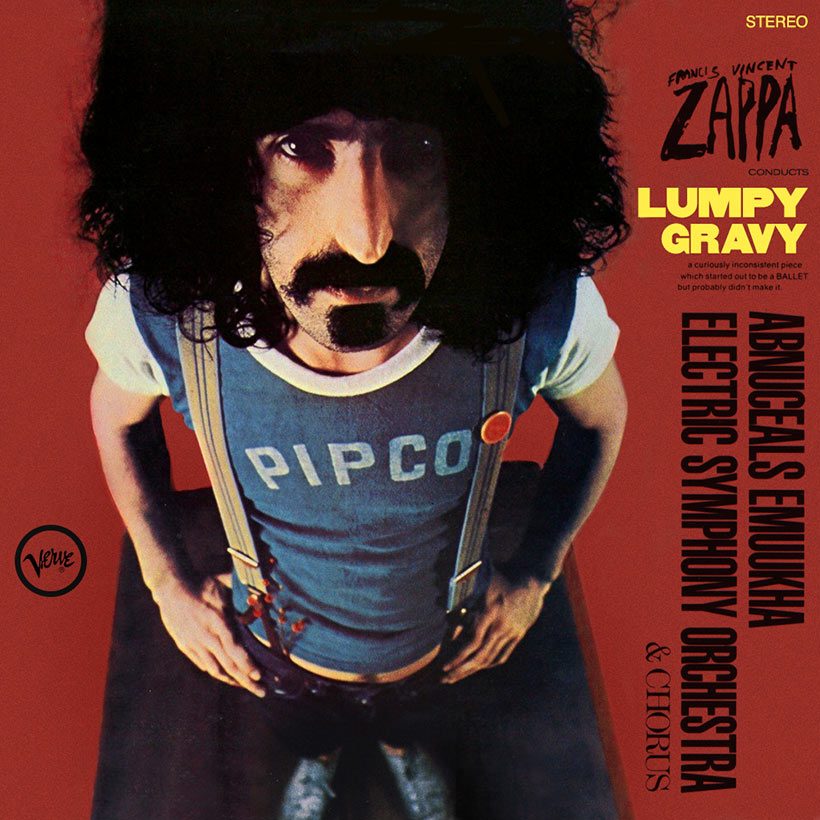How Frank Zappa Cooked Up A Classic With ‘Lumpy Gravy’
An inspired piece of cutting-edge experimentation, Frank Zappa considered his 1967 album ‘Lumpy Gravy’ to be one of his absolute masterpieces.

For a start, there’s the title. Lumpy Gravy? Even by the standards of the psychedelic 60s, that was one weird way of asking a potential customer to part with their money. If they did, however, they were richly rewarded.
Frank Zappa’s late wife, Gail, explained her husband’s modus operandi best: “For him, every album was just part of the same composition and everything was all one big piece of music. But the three particular pieces that he considered his absolute masterworks were Lumpy Gravy, We’re Only In It For The Money [The Mothers Of Invention’s third studio album was under construction while Zappa was rejigging his debut solo effort], and Civilization Phase III.”
Listen to Lumpy Gravy right now.
Living up to its title, Lumpy Gravy’s recording process was initially fraught. Having composed the entire thing himself, Zappa enlisted the assistance of a bunch of classically trained musicians he dubbed the Abnuceals Emuukha Electric Symphony Orchestra, but didn’t perform on the album himself – other than to conduct from his rostrum.
The musical ensemble was top-notch and later referred to as the crème de la crème of West Coast sessioneers: folks like Victor Feldman, the English vibes master; the woodwinds of Bunk Gardner; drummer John Guerin; French horn players Vincent DeRosa, Richard Parissi, and Arthur Maebe; soundtrack ace Pete Jolly, and guitarists Dennis Budimir and Tommy Tedesco. Such musicians didn’t immediately grasp the intent of their wild-eyed, woolly-haired employer, but he was embarking on a more ambitious venture than anything dreamed up by either Phil Spector or even Brian Wilson. Zappa’s apparent eccentricities gave grist to the cliché: don’t judge a book by its cover.
Lumpy Gravy was inspired by Zappa’s hero, Edgar Varèse, the experimental world of musique concrète, John Cage, the vogue for cut-up tape experimentation, and the whole avant-garde scene which infiltrated certain strands of rock circa 1966/67. In fact, the music was first released in a different form, on a four-track cartridge, in 1967, and then re-edited that same year for a 1968 vinyl release.
One could argue all day as to whether Zappa ever was a rock musician per se. A groovy early instrumental version of “King Kong” suggested he wasn’t, while the spry spy theme parody “Duodenum” was an unheard-of delight back then. If Lou Reed wasn’t convinced, David Bowie absolutely was, and took to performing Zappa’s songs in his late 60s bands.
While Lumpy Gravy isn’t necessarily stuffed with obvious “hits”, there are certainly stand-out moments across its two parts, with fans finding that they could trace some elements to other appearances in Zappa’s fast-growing body of work.
Zappa’s thing – paranoid West Coast anarchy coupled with a desire to never take yourself too seriously (while taking everything very seriously indeed) lends the album a two-faced value. Not many chose to follow his path, though Captain Beefheart’s Trout Mask Replica and Tim Buckley’s more out-there albums suggest that Zappa had kindred spirits (incidentally, both men spent some time working with – or for – him).
So, don’t be put off by the “I hear Zappa is great, if a trifle hard to comprehend” brigade. Satires, chaos, and challenges lie ahead for the listener. And that’s no bad thing.















Adriano Fonseca
November 11, 2017 at 7:21 pm
Crazy album for crazy people… I’m crazy!!!
VeedonFleece
May 13, 2023 at 5:40 pm
Frank Zappa was a genius, his music in all its iterations is beautiful
Vito Tuxedo
June 22, 2023 at 5:43 pm
Lumpy Gravy is a brilliant composition in two movements—namely, Side 1 and Side 2 on the album. There were segments that hooked me from the beginning when I first heard it in 1968, interspersed with “experimental” segments involving tape edits (splices of recordings played at double speed), and sections of dialog, some of which is spoken by people who are either genuinely stoned outa their gourds or are brilliant actors.
Anyhow, I can’t even guess how many times I’ve listened to it since 1968. Just today I listened to it twice, back to back. Everything fit; it’s a masterwork of juxtaposition between chaos and order, dissonance and harmony, tension and relief. As far as I know, it has never been equaled. Someone might approximate it with a similar approach, but it’s unquestionably a unique work of genius.
It requires an open mind, and I don’t think it’s possible to appreciate it fully until you’re familiar with it, but the payoff is worth it. You’ll be rewarded with new discoveries every time you listen.